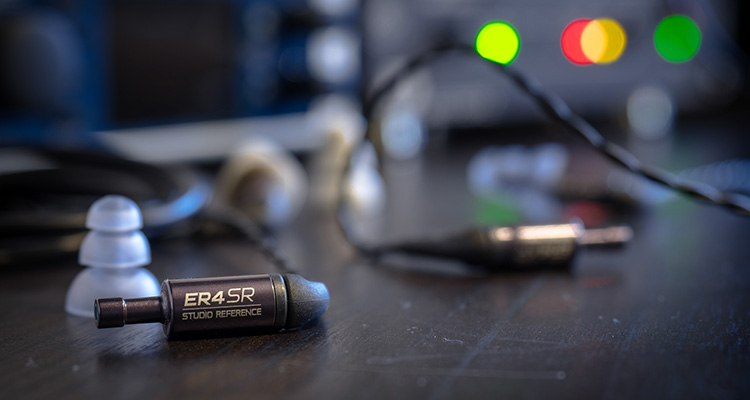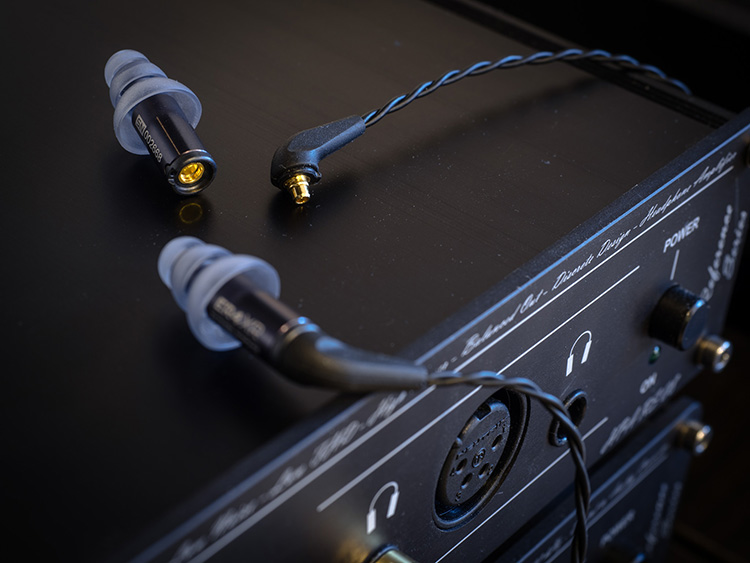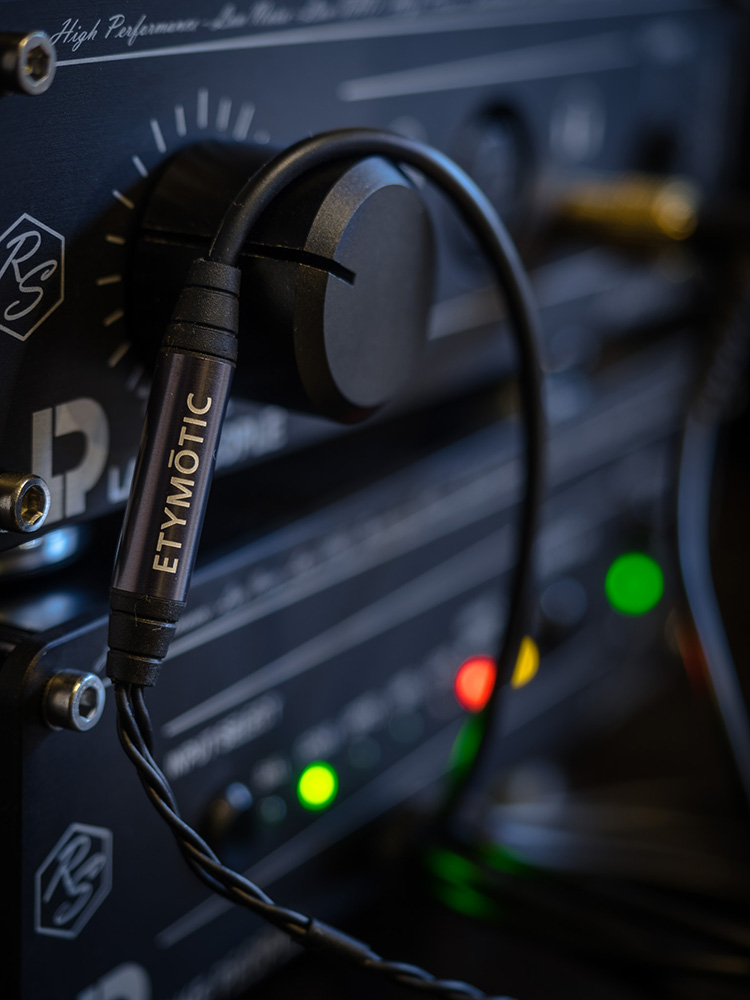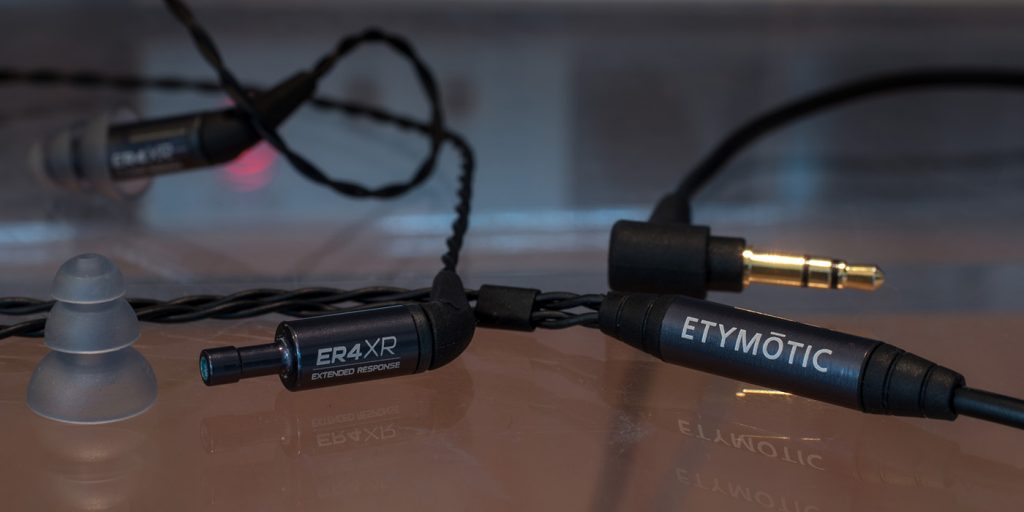Etymotic Research created one of the most iconic classic IEMs with the ER4S. It has ever since been the in-ear to beat in regards to neutrality. Hindering itself with a rather functional design that lacked the attractive build of hifi competitors, I personally had more of a love/hate relationship with this pair of earphones, that I perceived as bright and fatiguing.
In 2016, Etymotic decided to relaunch the ER4 and offers two new products for consumers: The new SR (Studio Reference) and the XR (eXtended Response) at 349 $ each. If you’re interested in the ER4SR, I suggest jumping forward to the category ‘Selected Comparisons’. This article will mostly focus on the ER4XR, one of my new favorite pair of in-ear monitors.
Packaging & Accessories
The new ER4 come shipped in a sleeve cardboard packaging. Included in the box are measurement documentations matching the serial number.
Etymotic includes a big durable pouch with many separate compartments. Since the earphones themselves are quite small, the size and space leaves me a bit puzzled. Even with all accessories in the case, the IEMs just take too little space to be asking for such a thick pouch.
Aside from the protective pouch, a set of the new ER4 includes a 6.3mm adaptor (with a nice rubber grip), multiple triple-flanges in two sizes, foam tips, a cable clip and clean cerumen filters with replacement tools. The two sizes of triple-flanges don’t match the design. Whereas the default tips have a cool blue-ish half-transparent look, the bigger size comes in an ugly light gray. The foam tips are also more of a less-than-ideal solution. They are coarse-pored, not ergonomic and scratchy.
Build Quality, Design & Comfort
Etymotic has stepped the game up from the previous ER4 monitors. Gone is the plastic design. Please welcome an aluminum-built body with replaceable cable. The tiny shell with a long cylinder design features a dark navy color with a hard-printed serial number. The new ER4 is damn sexy and feels great in the hands, too.
Lesser so in the ears, though. Sadly, comfort was an issue for me. The ER4 tube design has always been about deep insertion. Apparently, my ear canal is too big for even the larger triple-flanges. There was practically nothing stopping me shoving the IEM deeper than anything I have ever put inside my ear canals. And yes, it hurts. Twisting the IEM trying to achieve a seal did not help the cause. On the second day, I could not stand the pain and had to pause the review process for a few days.
Since the itchy foamies included by Etymotic wouldn’t work for me either, I bought myself large-sized Comply T-100. This improved the comfort a lot and I suggest that willing buyers also add these to the basket. I also thought of another solution that I sadly could not try myself because the review is based on a loaner unit: I would have liked to try to cut off the top third portion of the larger triple-flanges. If anybody else encounters similar issues as me, please try this out for me and let me know in the comments below.
Cable
The replaceable cable won me over quickly. The build quality is simply superb and I wish custom monitors were equipped with a similarly high-quality cable. It is long and heavy, which gives it a very premium feel. The cable is only braided above the Y-split and I like how little memory it has. The cable practically flattens itself out when holding up. I am also a big fan of right-angled terminations and this one even fits into the Chord Hugo without an additional adaptor.
However, I do have one issue and that is microphonics. Bumps on the cable are forwarded loudly and directly into the ear. This would have been really easy to avoid if the connections had a stronger angle. The shallow angles do not allow the cable to be worn over-ear, at least not comfortably. What a facepalm-worthy bummer!
If you are thinking about buying the cable for your other IEMs with MMCX connection, please note that Etymotic included a small bump that only fits into a dent on the new ER4. Thus the cable should not fit on other earphones but perhaps it would be worth it to try to carefully cut the bump away. Again, since the review is based on a loaner unit, I could not try this.
In case you were wondering, the cables for ER4 XR and SR are the same and interchangeable.
Sound
Tuning
To my ears, the Etymotic ER4 XR is close to perfectly tuned. It is this very reason I did not write an ER4SR & ER4XR dual review but instead decided to mainly focus on the XR. A more detailed comparison will follow later. The XR has an oh so carefully bass boost that is not necessarily perceived as such – depending on the listening volume. All frequency ranges come together nicely and form a very coherent and complete package. Etymotic will try to make you believe that the ER4SR is the neutrality king but based on the research by Harman – namely the Olive-Welti target response -, the ER4XR is closer to what I believe is a perfect blend of neutrality and natural sound.
This tuning results in great clarity and very little coloration. Exemplary!
Bass
If you used the ER4 S or SR before, chances are high you perceived the bass as not well extended. Possibly you have claimed the single driver has reached its limit, as is usually the case for single balanced armature designs. However, the ER4 XR with an extended response will prove you wrong. The extension is there, capably reproducing bottom and ground. The amount is never overpowering and provides a surprising amount of punch. Coming from pricier multi-BA designs, I would argue the texture could be more detailed, but overall the bass performance is to my liking.
The ER4 XR really does not have too much bass, quantity is exactly right for me. But chances are high some consumers might want to add a few pinches, especially if they are used to big boom and heavy impact from cheaper priced dynamic driver designs. Sadly, the ER4 XR does not like to be equalized too much, the bass performance will quickly distort when boosted further.
Mids
There is but a minor flaw with the mids. I find the upper midrange to be slightly boosted. This was possibly done on purpose to add air or trick the user into thinking the ER4 XR has a higher resolution. Most probably, however, the upper midrange wants to bring mids more forward for better layering or it is as demanded by professionals. This tuning quickly unveils a little harshness in recordings and using the ER4 XR for mixing or recording, will make sure the output will be tuned softly and enjoyably. However, just as recently criticized with the Beyerdynamic DT 1990 Pro (which is even less forgiving), this adds a bit too much crunch for my taste as a consumer.
Other than that, the midrange is nicely done and the transition from bass to mids is simply wonderful.
Treble
Both the ER4 SR and XR perform amazingly in the treble. This is some reference tuning with a smoothness and quantity that is just right. It’s free from coloration and clouding. No veil, no sharpness, no artificial warmth, nothing.
Soundstage & Resolution
Etymotic really punched hard in what is possible with a single BA receiver. Thanks to the tuning and its clarity, the ER4 XR can reveal more micro details than most of the competition. But the capacity limit shows in the dynamics. The ER4 XR can sound a bit flat and unemotional, occasionally compressed. If a lot is going on in the music, S-sounds can lose some of their crispness, too.
Even on very spacious recordings, the soundstage remains very closed and intimate on the ER4 XR.
Matchability
Surprisingly, the new ER4 need some fire to be lit under them, these don’t drive themselves. The output volume is quite low. Depending on your preferred listening volumes, a portable amp might be necessary. Personally, for me the iPhone 6S Plus (yes, the one with a headphone jack), was powerful enough. Though reaching 80% at times, I did not find the control to be lacking. The warmish nature is an enjoyable pairing, too. The treble will shine more with a more transparent device, though.
Pulling out the Chord Hugo, I preferred the overall tonality. However, I was not able to push out any more micro-details are remove the XR’s flaws. So in a way the ER4 are difficult to drive, but at the same time aren’t. I’d say these don’t scale much in performance, but overall they need some more juice to output common volume pressure.
Select Comparisons
Etymotic ER4 SR
The ER4 SR and XR are similar in many regards. Price, build, packaging and accessories are identical. I was told the drivers are not the same, but regarding the high similarities in sound design, I wouldn’t be surprised if all differences are only achieved by a small filter or similar design change.
From my listening experience, the SR have too little bass and noticeably roll off in the low-end. Bass information is simply missing at low volumes. I am absolutely sure that some will disagree with me, but I am not a person that likes to turn up the volume high – and you shouldn’t either. The XR’s bass quantity is nowhere exaggerated, at best slightly above natural, though free from bleeding.
Nonetheless, the SR can impress with a dry and analytical character, likewise with amazing clarity. Mids can shout even a bit more than with the XR, making this a very mid-centric monitor. Treble is a tiny bit less splashy and tighter. Probably because the single driver needs less energy for pushing the bass and thus has more resources for mids and treble. When it works, it works formidably well, for example, the guitar solo in Master of Puppets.
I have no doubt that the SR can be used as a professional tool (dare I say studio reference), but overall the tuning of XR should please more consumers without missing out on the legendary Etymotic sound.
InEar StageDiver 2
The InEar StageDiver 2 has long been my favorite conservatively priced universal IEM. Suddenly, along comes the ER4 XR rattling the podium. I still haven’t made up my mind about which IEM I like more. From now on, both will be a regular recommendation from me.
The SD2 clearly takes the cake for comfort – no awkward penetration needed! Both are built extremely well and I wouldn’t fear that either broke. Unfortunately, the cable cannot be worn over-ear with the ER4. Also, the Etymotic are more difficult to drive which consecutively make the SD2 the better option for on-the-go. Both have cerumen filters for increased longevity.
At home, I slightly prefer the ER4 XR because of the tuning. The Etymotic does not have as romantically lush mids, but the SD2 sounds veiled and muffled in comparison. I complained that the ER4 has slightly too much upper midrange. Well, the SD2 has too little and overall I think the ER4 is closer to neutral. Also, the treble is smoother even though the SD2 has darker higher frequencies. While neither really impresses with sub-bass, I found the SD2 to have a better treble extension. The StageDiver also do not play as forward and bring less of that in-your-face attitude of the Etymotic.
In the end, it’s a very close call. Sonically, I bow down to the ER4 XR and applaud the single BA receiver’s capabilities. In all other respects, the SD2 wins the duel for me.
InEar ProPhile-8
ER4 XR, meet your maker! Ok, ok, this is an unfair competition since the PP8 costs more than three times as much, but both monitors have a similar tuning. Other reviews I found online will tell you the ER4 XR is high-end or the single best IEM. I just think it wouldn’t hurt to bring things back into perspective.
While my review of the ProPhile-8 is still in the works, I am already dead set on the verdict. Both the PP8 (no switches activated) and ER4XR manage to hit the sweet spot between neutral and natural sounding, but where the ER4 is dry and flat, the PP8 opens a new dimension and comes alive. Due to a better low-end extension, the InEar can create rumble with authority and apply much better texture on bass than the Etymotic. Voices have better weight and are meatier and avoid all kinds of harshness. They are rendered in depth too, something that the ER4 failed to achieve. In the higher frequencies, the PP8 never loses control, which I cannot say about the ER4XR. The treble tuning is similarly smooth but the PP8 has a little bit more sparkle with more air. The soundstage of the PP8 is limitless in comparison. However, it is absolutely impressive how much the Etymotic can keep up considering the price gap.
If you like the ER4 XR, you will love the PP8! Or if you have wet dreams of the ProPhile every night (which you should) but costs are an issue, the ER4 XR is probably the closest you can currently get in a mid-tier category. I highly recommend both IEMs!
Our Verdict
Wow, what a positive surprise by Etymotic. In the past, I have forced myself several times to like the ER4 but it simply never worked out. As a result, I ignored the Etymotic brand for a while comforting myself “it is simply not for you.”
Those days are gone now. I have finally become a fan! A little bit more bass is all it took for the ER4 family to make the important step to jump from neutral to natural sounding and follow the contemporary trend. For a universal daily-driver IEM, I would wish there were a solution to better avoid microphonics of the cable and to play louder from an average source. Nonetheless, build quality is superb and the sonic performance is great. This is an easy recommendation for any aspiring audiophile.
Technical Specifications
| Frequency Response | 20 Hz – 16 kHz |
| Transducers | High performance, balanced armature micro drivers |
| Noise Isolation | 35-42 dB |
| Impedance (@1kHz) | 45 Ohms |
| Sensitivity (@1 kHz) SPL at 0.1v | 98 dB |
| Maximum Output (SPL) | 122 dB |
| Cable | 5 ft Detachable |
| User Replaceable ACCU-Filters | Yes |
| Warranty | 2 Years |
| Custom-Fit Option | Yes |





